Residential Palace Darmstadt
The Residential Palace Darmstadt (German: Residenzschloss Darmstadt, often also called Stadtschloss) is the former residence and administrative seat of the landgraves and from 1806 to 1919 of the Grand Dukes of Hesse-Darmstadt. It is located in the centre of the Hessian city of Darmstadt.
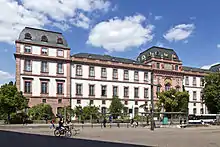
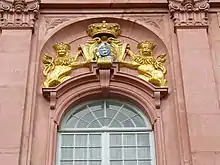
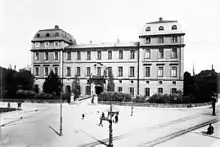

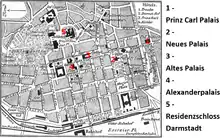
Today the castle is the seat of the Technische Universität Darmstadt and the German-Polish Institute.
Location
Today the castle is located in the centre of the Darmstadt, at the eastern end of the Rheinstraße, which leads from the west into the city.
History
The origins of the castle lie in the Katzenelnbogen time. In the middle of the 13th century the counts of Katzenelnbogen built a moated castle in Darmstadt. In 1330 Darmstadt received town rights, one year later the castle is mentioned for the first time in a document. From 1386, the moated castle loses importance and becomes a widow's residence and secondary residence. In the following two centuries, the counts of Katzenelnbogen extended and rebuilt the castle again and again. Until the middle of the 15th century the castle was transformed into a representative castle and Darmstadt became Katzenelnbogen's second residence. What remains of the moated castle are the form of the central church courtyard and the outer walls of the manor house. When the last count von Katzenelnbogen died in 1479, Darmstadt fell to Henry III, Landgrave of Upper Hesse. When Philip I took over the government offices in 1518, the castle was destroyed for the first time in an attack by Franz von Sickingen. The castle was rebuilt in the following years, but with essentially the same defensive structures. During the Schmalkaldic War in 1546 it was destroyed again by imperial troops. Landgrave George I considerably extended the castle from 1567 to a Renaissance complex and secured it with moats and bastions. The half-timbered floors of the former palace and the hall are rebuilt from stone. The buildings received new roofs. Christoph Müller, Jakob Wust and from 1580 Jakob Kesselhuth developed the old moated castle into a residential palace. After 1589 the office, the stables and the arsenal were built, which no longer exist today. From 1594, the landgrave had orphans educated in the castle. From 1595 to 1597 the Kaisersaal (Emperor's room) and the church were built. The tympanum corridor, which connects the manor with the church, was also built.[1][2][3][4]
The Wallhäuschen, a gate building in the north of the castle, was built in 1627 by Jakob Müller. The bell building was built from 1663 to 1671 according to plans by the architect Johann Wilhelm Pfannmüller. Darmstadt was attacked by the French in 1693. The keep of the castle was destroyed. Landgrave Ernst Ludwig commissioned the French architect Louis Remy de la Fosse to plan a new baroque palace with four large wings in 1715, after the palace's chancellery had burned down. This was to completely replace the old palace. Due to lack of money, however, only two wings were completed by 1726. These were to remain the last major structural changes to the castle. When Hessen-Darmstadt joined the Confederation of the Rhine in 1806, the castle became the seat of the Grand Dukes of Darmstadt. At the beginning of the 19th century, the upper floors of the new castle were furnished and fitted with window glazing. In 1842, the university and state library and the grand ducal collection with natural history cabinet moved in. Since the 18th century the castle has been less and less inhabited by the grand dukes. More and more institutes were admitted and some of the rooms were reserved for state guests.[1][2][3][4]
In 1893, under Ernst Ludwig, Grand Duke of Hesse and by Rhine, structural measures were again being taken. Thus the extension with a tea pavilion was built on the Herrenbau. In 1924, the castle museum moved into the old area of the castle.[1][2][4]
After the World War I, the castle passed into the possession of the People's State of Hesse. On the night of the fire in Darmstadt from 11 to 12 September 1944, the castle burned down to the outer walls. Reconstruction began in 1946 and was not completed until the early 1970s. 2008 An overall repair is carried out, which is planned for a longer period of time. 2016 The bell construction is completed. The outer appearance was almost completely restored. Today the castle is the seat of the Technische Universität Darmstadt and the German-Polish Institute.[1][2][3][4]
Construction
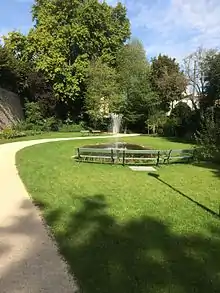
Today, the castle consists of two wings with an S-shaped ground plan under a gambrel that meet perpendicularly. The east wing is single-storey, the west wing two-storey. The castle is divided into three areas: the outer fortification, the Renaissance castle and the Baroque castle. Towards the town one comes across the mighty Baroque building, which consists of two wings. It is quite symmetrical and characterises the image of the former castle to the south and west.
The north is occupied by a park that belongs to the old fortification. In its place was once the deep moat that completely surrounded the Residenzschloss Darmstadt. Also recognizable in the north and northwest are the mighty bastions that were to protect the castle in this direction with the advent of firearms.
In the southeast is the bell building. It is a tall building with a 39 m high bell tower on its courtyard side.
The centrepiece of the Residential Palace Darmstadt is the old Renaissance palace. Today it still has the almost triangular shape of the old core castle and consists of the castle wings Herrenbau, Weißer Saalbau, Kaisersaalbau, Kirchenbau and the church courtyard. Access to the courtyard is from the north, as it was then. Here a portal building was placed in front of which there was originally a drawbridge. From the town, a less fortified gate leads directly through the baroque castle into the southern courtyard.
Music festival Schlossgrabenfest
Since 1999 the Schlossgrabenfest, the largest music festival in Hesse and one of the largest open-air events in Germany, has taken place every year on the last weekend of May around the Residential Palace Darmstadt and Friedens- und Karolinenplatz in Darmstadt. The musical spectrum ranges from rock, pop, electro, reggae and hip-hop to soul and jazz.[5][6]
References
- "Schloss". www.darmstadt-stadtlexikon.de. Retrieved 2019-11-01.
- "Schloss und Marktplatz: Darmstadt". www.darmstadt.de. Retrieved 2019-11-01.
- Darmstadt, Technische Universität. "baubeschreibung". Technische Universität Darmstadt (in German). Retrieved 2019-11-23.
- Darmstadt, Technische Universität (2013-04-08). "Das Darmstädter Residenzschloss – eine Chronik". Technische Universität Darmstadt (in German). Retrieved 2019-11-23.
- "Historie". Schlossgrabenfest 2018. Retrieved 2019-11-23.
- GmbH, Echo Zeitungen. "Schlossgrabenfest 2019 - Hessens größtes Open-Air vor dem Start - Echo Online". www.echo-online.de (in German). Retrieved 2019-11-23.